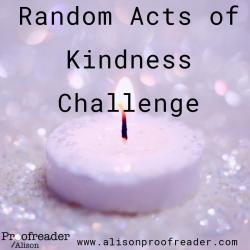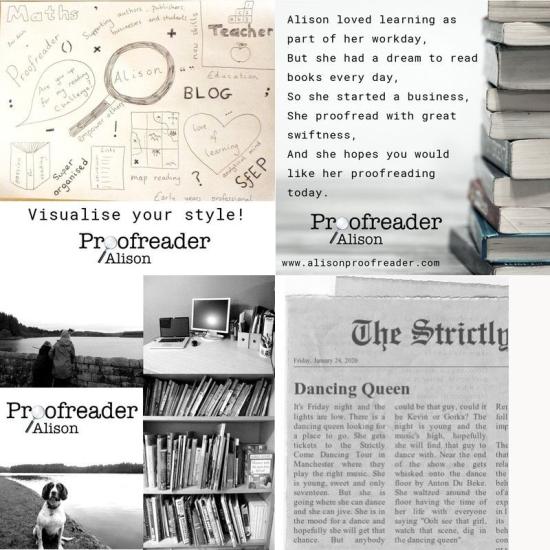LinkedIn challenges are fun and interactive, and I use them to engage with my target audience. My background is in education, and I have spent years engaging with parents and getting them involved with their children’s learning. The best way I found was with a challenge – something they could do together with their child. So I adapted the same principle to my proofreading business.
 Setting a challenge
Setting a challenge
To set a challenge, you need to know your audience. Who are you trying to engage with? What sort of challenge would they want to get involved in? Then make it relevant and topical. Keep up to date with recent hot topics, relevant to your line of business. People get more engaged if there is a reason or a discussion point, such as in my reading challenge.
I strongly believe that children should read every day, so I set the challenge for parents to read with their children every night for a week and at the end of the challenge share their child’s favourite story. My post was topical and people got involved and shared their love of stories. It appealed to authors, publishers and fellow proofreaders. It was my most successful post and trended on LinkedIn, receiving more than 1,000 views.
 Challenges can also reflect national events and times of the year. During National Storytelling Week I set a storytelling challenge to create a story together. This appealed to my audience of authors and let them showcase their writing. However, this post was less successful. I was hoping to generate a complete story over the week. The first day went really well and I chose the start to the story. But unfortunately no one commented to complete the next part of the story. I tried posting it on different days, times and with different images – even the author of the start of the story re-shared it – but still no takers. People like the initial idea of a challenge, but maybe I was overoptimistic in attempting to build on my challenge every day. Possibly it was too time-consuming a task; so since then I’ve tried to keep each challenge manageable and easy to fit in with people’s daily lives.
Challenges can also reflect national events and times of the year. During National Storytelling Week I set a storytelling challenge to create a story together. This appealed to my audience of authors and let them showcase their writing. However, this post was less successful. I was hoping to generate a complete story over the week. The first day went really well and I chose the start to the story. But unfortunately no one commented to complete the next part of the story. I tried posting it on different days, times and with different images – even the author of the start of the story re-shared it – but still no takers. People like the initial idea of a challenge, but maybe I was overoptimistic in attempting to build on my challenge every day. Possibly it was too time-consuming a task; so since then I’ve tried to keep each challenge manageable and easy to fit in with people’s daily lives.
 On the Random Acts of Kindness Day I set a challenge to do an act of kindness. I felt it was a great opportunity to encourage people to think of others and to go above and beyond.
On the Random Acts of Kindness Day I set a challenge to do an act of kindness. I felt it was a great opportunity to encourage people to think of others and to go above and beyond.
 When creating a challenge, image choice is very important in attracting your audience to the post. I have found bold images have worked for me, and I type a clear message on top of them. Therefore, people don’t have to scroll through my text to see what my challenge is all about. I think of them as an advert containing all the basic information necessary to promote engagement.
When creating a challenge, image choice is very important in attracting your audience to the post. I have found bold images have worked for me, and I type a clear message on top of them. Therefore, people don’t have to scroll through my text to see what my challenge is all about. I think of them as an advert containing all the basic information necessary to promote engagement.
For a bit of fun at Christmas, I set a Christmas homework challenge, to get everyone in the mood for a magical time. Life needs to be filled with moments of fun!
The Comms Creatives challenge
I love challenges so much that I undertook another company’s challenge. The 31 Days of Creativity Challenge was set up by Comms Creatives, a marketing company that runs courses to inspire creativity. Every day for the month of January, Helen Reynolds, the owner, sent me an email with a creative challenge to post on social media. I used the challenge to learn new skills, stretch myself and advertise my proofreading business.
The challenges included some outright fun and silly ones to get my creative brain in gear: creating words using spaghetti, making a picture with your meal (I created the Hungry Caterpillar using grapes and cucumbers), creating origami, choosing an uplifting song, inventing a sandwich for your hero (mine is Joey from Friends, who loves sandwiches) and writing your day in emojis. Some challenges were quizzes to find out your creative personality and what drives you. Turns out that I am a producer.
Quite a few of the challenges were to get participants thinking and talking about their inspirations. For example, creating a video about what advice you would give yourself if you could go back in time (mine were believe in yourself, everything happens for a reason and trust your instincts), writing about what inspires you, visualising your style and sharing what you believe in (I believe in a love of learning).
Part of the challenge really tested my creativity and put me out of my comfort zone, for example writing a limerick (see the image above for mine), drawing tasks (I hadn’t drawn since school), creating videos, creating a story using a plot generator, writing a poem using magnetic letters, creating a handwritten message, creating a calligram (I did a snowflake using words linked to proofreading) and creating a newspaper article using a generator.
 Some of the challenges were about reminiscing about my life and these seemed the most popular of my social posts – I created a collage of photos of my life and did something from my childhood. My most successful post during the challenge was a video clip of the game ‘Mousetrap’, which trended on LinkedIn. People obviously like reminiscing about their lives too and seeing connections with others.
Some of the challenges were about reminiscing about my life and these seemed the most popular of my social posts – I created a collage of photos of my life and did something from my childhood. My most successful post during the challenge was a video clip of the game ‘Mousetrap’, which trended on LinkedIn. People obviously like reminiscing about their lives too and seeing connections with others.
I really enjoyed completing the 31 Days of Creativity Challenge: I gained confidence to post regularly on social media. I learned new skills, such as how to create videos and newspaper articles, and stretched myself to be more creative. I made a lot of connections during the challenge with other people doing the challenge at the same time. It was great each day to see how everyone had undertaken the challenge and to comment on their progress. Comms Creatives regularly run the challenges and do some on other platforms too.
Why do the challenges?
Challenges are motivating to others and encourage interaction. They allow me to engage with my target audience by tuning in to what is important to them, relevant and purposeful. Hopefully, building relationships through engagement will lead to future work connections. The challenges stand out on social media as being different and fun, and people always like a challenge. They are a good way to test yourself, find out what you are capable of and learn new skills.
Have a go: I challenge you to set a challenge for your target audience. Are you up for the challenge?
 Alison Gilbert is a freelance proofreader, qualified teacher and early years professional with a love of learning. She specialises in educational and mathematical proofreading. She is an Entry-Level Member of the CIEP based in Ramsbottom, Lancashire.
Alison Gilbert is a freelance proofreader, qualified teacher and early years professional with a love of learning. She specialises in educational and mathematical proofreading. She is an Entry-Level Member of the CIEP based in Ramsbottom, Lancashire.
Follow the CIEP on LinkedIn! (And Facebook. And Twitter.)
Proofread by Victoria Hunt, Intermediate Member.
Posted by Abi Saffrey, CIEP blog coordinator.
The views expressed here do not necessarily reflect those of the CIEP.
